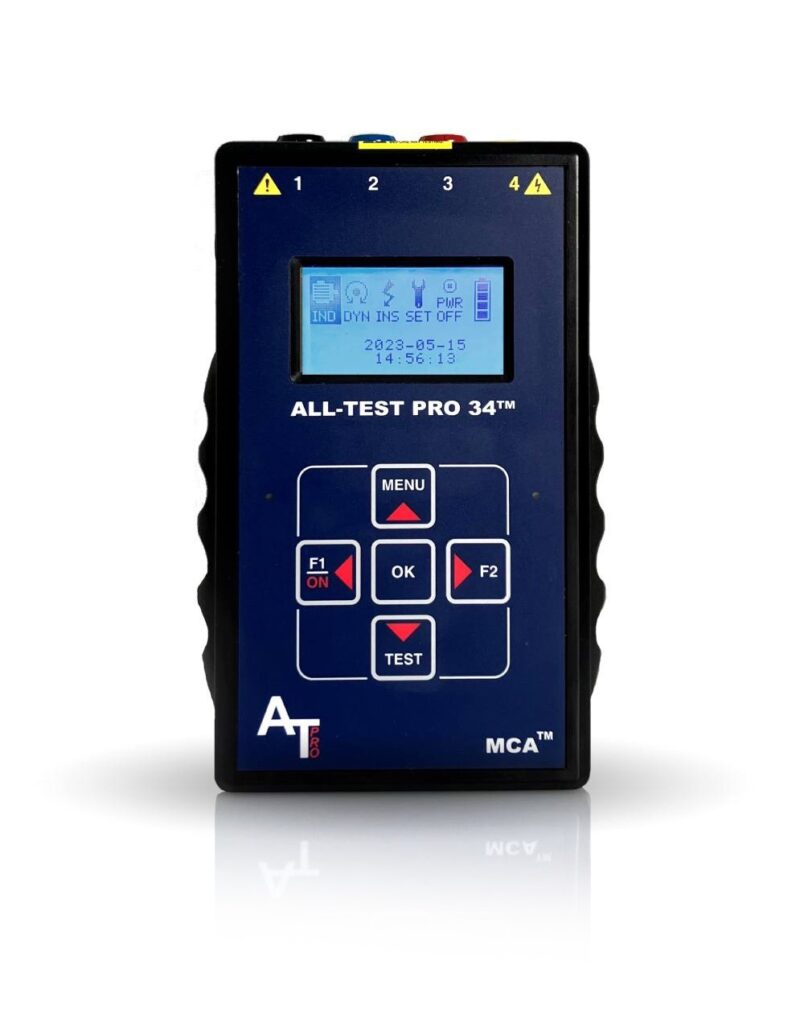Beginner’s Guide to Motor Testing

Motors when installed play a critical role in many manufacturing efforts. Businesses in all industries rely on machines to drive profits, so testing these motors ensures your investments are available for demanding tasks.
ALL-TEST Pro removes the mystery from motor testing by providing easy to use, handheld instruments to provide step by step procedures to quickly and easily test, even the most complex motors, from the controller or directly at the motor itself. Whether it has been months since your last equipment inspection or are just curious about the status of installations, ALL-TEST Pro wants you to understand that testing a motor for the first time is not as scary as it seems.
Why Is Motor Testing Important?
Motor testing improves machinery and plant availability by eliminating unscheduled machinery shutdowns and failures. Maximized revenue is achieved when these critical machines are operating, so testing motors must be a top priority for a successful company.
With the proper instruments effective and complete motor testing takes just moments to perform.
1. Not All Motor Faults Are Obvious
Physical senses of sight and sound provide a valuable indication of the proper operation of motors, but usually, by the time these senses are aware a fault is present, severe and expensive damage has already occurred. ALL-TEST Pro instruments provide the tools and measurements that identify faults in all motors or other electrical equipment before permanent and expensive damage occurs. The instruments can locate loose connections, degrading insulation or other faults that may arise from changing temperatures, multiple start-ups, or excessive vibration.
2. Identify Motor Issues as They Develop
Insulation, windings, stators and other motor components experience wear and tear over time. Knowing the condition of the motor’s insulation is critical for extended trouble-free operation. ALL-TEST Pro devices enable you to confirm good motors as well as identify developing motor problems beyond typical ground faults. (Ground faults occur when weaknesses develop in the insulation between the motor windings or any other energized part of the motor and the motor frame. This insulation is normally referred to as “groundwall insulation”.)
3. Motor Testing Promotes Safety Initiatives
Motors that overheat are a danger to employees, plants or facilities. User-friendly instruments by ALL-TEST Pro measure resistance unbalances and other developing faults that cause motors to overheat with a high level of sensitivity and accuracy. They help pinpoint where a repair is necessary before an issue occurs.
Common Motor Testing Procedures for Beginners
ALL-TEST Pro instruments provide on screen detailed step-by-step testing instructions on how to test motors and the results of tests in plain language, eliminating the need to spend time reviewing and analyzing colorful but meaningless graphs.
- Low-voltage motor testing:Locate faults between conductors in the motor windings. ALL-TEST Pro instruments send low-voltage AC signals through motors winding systems to fully exercise the motor’s insulation to identify insulation degradation in the very early stages to ensure safe operation using non-destructive motor testing.
- Insulation resistance testing: The ALL-TEST PRO 34™ provides further insight into the overall condition of the motor’s groundwall insulation. Megohmmeters only detect weaknesses in the insulation between the winding and ground. Our MCA™ testing solution fully tests the condition of motor groundwall insulation as well the ability to detect faults in the stators, rotors, cables and all insulation systems. Additional testing techniques quickly test the groundwall insulation to diagnose moisture problems, cracking, thermal degradation and early deterioration within the motor system. These tests eliminate the need for time-consuming time-based insulation tests such as the polarization index.
How to Test a DC Motor Safely
Beginners should follow all basic electrical safety tips when motor testing. For those new to the motor testing process, ALL-TEST Pro provides step-by-step guide outlined below you can reference when using MCA solutions for deenergized motors:
- Disconnect wired connections running between the motor and DC battery.
- Look for uninsulated portions of the conductor to perform the test.
- Ensure the DC voltage to the motor is disconnected from all parts of the equipment.
- Using a “confirmed” working voltage tester, verify all power has been removed from the motor leads that are going to be tested.
- Fasten test lead clips to motor listed motor leads.
- Select the winding test from the testing menu on the testing instrument.
- Connect the proper instrument test lead to the correct motor lead before performing tests.
- Follow the on-screen instructions to test the entire motor coils.
- Always refer to your motor’s manufacturing manual to be certain of connections.
ALL-TEST Pro Products for Accurate Motor Testing
ALL-TEST Pro specializes in portable devices ideal for deenergized motor testing. When testing a DC motor, products such as the ALL-TEST PRO 34™ and MOTOR GENIE® give you real-time information about ground faults, internal winding faults, open connections and levels of contamination within your setup.
Request a quote for our motor testing instruments today.



